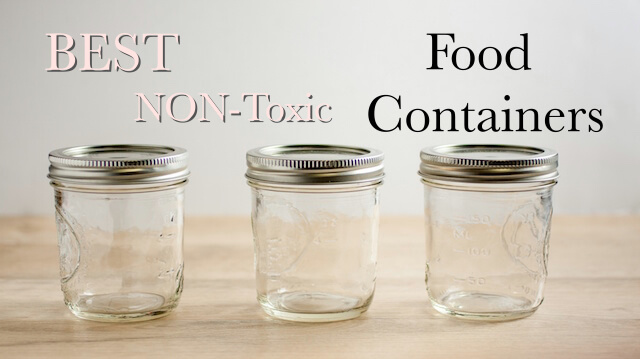
Plastics are affordable, lightweight and damage-resistant, so they are the easiest choice for food storage and lunch containers. But are they safe?
You may have heard about the toxin bisphenol-A or BPA. Many products are now sold with a “BPA free” label, which is supposed to assure us that a product is safe. However, these plastics are still made from unsustainable petrochemicals that exploit the earth. Experts are also warning that the removal of BPA doesn’t guarantee any level of safety for food storage.
We dove deep into this topic to clear up the confusion and determine the pros and cons of each type of food storage container available today. Read on to discover our top recommendations.
Plastic containers
There are definitely some valid concerns about putting your food in plastic. Particularly since we are most apt to let our babies and children use plastic items because they are soft and unbreakable.
Plastic containers are most damaging when heated (like in the microwave) or used with hot food or drinks. Heat allows BPA to leach out 55 times faster. Other factors that can increase the toxicity of plastic are frequent dishwasher exposure, harsh detergents, and wear and tear.
We don’t think plastics are worth using under any circumstances, because there are other safer options available.
If you still need plastic occasionally, avoiding those with the recycling codes 3, 6 and 7 will cut down on the worst of the toxins. Those with codes 1, 2, 4 and 5 are somewhat safer, though you should still avoid exposing them to heat.
BPA-free plastic
Removing BPA may constitute some improvement, but there are many other worrisome toxins in plastics. These include the following:
Phthalates: Used to keep plastic flexible — known to cause developmental and hormonal defects.
PBDEs: These chemicals are known to cause reproductive problems.
Acetaldehyde: A probable carcinogen.
Styrene: A nervous system toxicant.
PVC: Can leach lead, cadmium and mercury into your food.
Unfortunately, many products labeled “BPA free” still leach BPA when tested under everyday usage conditions. In addition, BPA is commonly replaced with BPS (bisphenol S) which was initially considered safer, but now has been detected in the urine of up to 81 percent of Americans.
And finally, a 2011 study published in an environmental journal reported that the vast majority of the 455 different types of commercially available plastics tested positive for the leaching of estrogenic chemicals. As you can see, it’s just not worth continuing our tainted love affair with plastics.
As a side note, many cans used to preserve food contain a plastic liner, so try to keep your consumption of canned food to a minimum if you want to avoid plastics.
Glass
 Glass is a great choice, since it is recyclable, sustainable, non-toxic and washable. If you are worried about safety, we recommend purchasing glass with a silicon coating.
Glass is a great choice, since it is recyclable, sustainable, non-toxic and washable. If you are worried about safety, we recommend purchasing glass with a silicon coating.
If you want to use your glass containers to reheat food, you can even buy containers that are tolerant to changes in temperature, such as those made of borosilicate glass (most commonly sold under the name Pyrex).
Stainless steel
Weight is sometimes a concern with glass, so in this case stainless steel is a better choice. You can place stainless steel containers directly on the stovetop to heat, but do not use them in the microwave.
The best options come with a stainless steel lid that has a clip. Be sure to seek out containers that do not have a plastic liner.
Silicon
Where flexibility and sealing are needed, silicon is the best choice. You can get suction lids and stretch lids made of silicon to compliment your stainless steel or glass containers.
However, silicon is still a man-made polymer and some studies indicate that it is not leach-proof. It seems prudent to use silicon only for lids and for the protection of glass and stainless steel containers, but not for direct contact with food.
If you are looking for a safe substance for baby products, 100-percent pure natural rubber is the best choice.
Waxed materials
We have seen some products popping up that are made of waxed fabric. These are great for dry items such as veggie sticks or baked goods, but they are not versatile enough for storing other foods.
The best non-toxic food storage container
After investigating all of the options, we recommend stainless steel as the best non-toxic choice. Be sure to purchase products with a fully steel lid and no plastic liner. These are easy for children to open and are not breakable. They are safe for the dishwasher and the stovetop or oven.
Save your delicious healthy food from getting spoiled with toxins; invest in some good quality containers to store leftovers or on-the-go lunches.
— Liivi Hess
Liivi is an Integrative Nutrition Health Coach and is training to become a doula. She inspires women to find peace and personal power by taking control of health and fertility naturally. Liivi‘s passion is ancestral nutrition and primal lifestyle design. She and her partner Will live between Toronto, Canada and Queenstown, New Zealand.
Sources:
http://www.nature.com/nature/journal/v401/n6755/abs/401763a0.html
http://jama.jamanetwork.com/article.aspx?articleid=182571&resultclick=1
http://www.examiner.com/article/best-food-storage-containers
http://www.nrdc.org/living/shoppingwise/food-storage-containers.asp
http://www.scientificamerican.com/article/bpa-free-plastic-containers-may-be-just-as-hazardous/
http://www.ecolife.com/recycling/plastic/alternatives-plastic-food-containers.html

